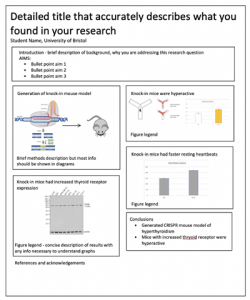Written by Amy Preston, Student Digital Champion and MRes Student in Physiology and Pharmacology

Introduction to Posters and Presentations
Presenting your research, whether part of your undergraduate dissertation or postgraduate research degree, is a huge part of academia. However, it’s often difficult to know where to start when making posters or presentations. There are a few different ways that you can approach them, so hopefully this post will give you some ideas!
Posters
The main thing to keep in mind for a poster is that it needs to be clear and rely on visual representation of your research. There are multiple tools you can use to make a poster. PowerPoint is useful, especially for posters in landscape orientation. You can also use Microsoft Word or Publisher, but these can be a bit trickier to use. Sometimes research groups will pay to use Adobe Illustrator which allows for figure-making as well. But it is up to you, and you don’t need to pay for expensive software if you don’t have the means to do so.
The majority of the poster should be focused on your methods and results, so make sure to keep the introduction concise and have a few short conclusions and future directions at the end to summarise. Depending on your course or the conference you are presenting at, you will likely have a specific format to follow – including orientation and size. Usually, posters are A0 size and portrait orientation, so make sure you adjust your font size to accommodate this – a good rule of thumb is 24pt font for main body text and at least twice this size for your heading if your poster is A0. If your poster format is portrait, it can be helpful to split the poster into two columns if you have quite dense figures, but this isn’t essential if your data doesn’t fit this way.

Presentations
Many of the same principles from posters apply to presentations and talks. Aim to make them clear, easy to follow and visually appealing. One way to help the audience follow along is to introduce each aim separately followed by its related methods and results (this is shown below). Or, depending on your data and how it fits together, you can introduce the aims all at once, then go through methods and results that follow on from each other. For example, if you found an unexpected result, what methods did you try next to further understand it and what did you find? Try to tell a story through your presentation.

Making good quality figures
An effective figure should be clear and not too busy. It can be really helpful to demonstrate your methods with figures, especially in posters to save words, or for presentations where the audience may not have the same specialist background as you. You can create simple methods figures using tools like Microsoft PowerPoint and Visio (which are available in the Microsoft Office package with the university) or use free tools with pre-made components and better freedom for drawing figures like BioRender and Inkscape. Think about how you can break down complex concepts in to easier-to-manage chunks, to help your reader see the big picture.

General tips to remember
- More visual cues, less words
- The main bulk of a presentation should be your methods and results – don’t take up too much space with the introduction, focus on your project
- Unless asked to, don’t put your abstract in your presentation – you will be wasting valuable words by repeating yourself
- Make your aims stand out – it really helps the understanding of the reader if they can refer back to them
- Keep the font big, and save words by using bullet points
- For each slide or poster section, use descriptive titles to help the reader follow along
- Don’t assume knowledge of your subject area – although there will be physicists at a physics conference, their area of research may be very different to yours!
Useful resources
- https://www.sciencegraphicdesign.com/blog/how-do-you-make-your-first-scientific-poster
- https://biorender.com/
- https://inkscape.org/
- canva.com
- https://blog.addgene.org/early-career-researcher-toolbox-free-tools-for-making-scientific-graphics
- https://www.york.ac.uk/hrc/postgraduate/opportunities/poster-competition/design-tips/
Hopefully you feel more confident presenting your own work, but above are some useful resources that help me when starting a new poster or presentation – good luck!

